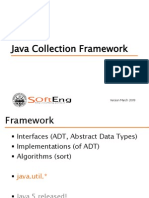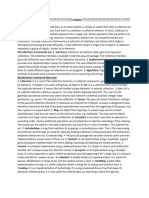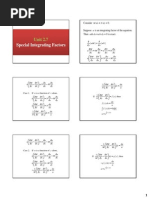0 ratings0% found this document useful (0 votes)
2 viewsJava_Collections_Framework_Beginner_Course
The document outlines a beginner-friendly course on the Java Collections Framework, covering its purpose, core interfaces, and common implementations. It explains the advantages of using collections, such as improved performance and flexibility, and provides examples of how to use different collection types like List, Set, Map, and Queue. Additionally, it highlights best practices, common pitfalls, and real-world use cases for collections.
Uploaded by
Santheep MadhavanCopyright
© © All Rights Reserved
We take content rights seriously. If you suspect this is your content, claim it here.
Available Formats
Download as PPTX, PDF, TXT or read online on Scribd
0 ratings0% found this document useful (0 votes)
2 viewsJava_Collections_Framework_Beginner_Course
The document outlines a beginner-friendly course on the Java Collections Framework, covering its purpose, core interfaces, and common implementations. It explains the advantages of using collections, such as improved performance and flexibility, and provides examples of how to use different collection types like List, Set, Map, and Queue. Additionally, it highlights best practices, common pitfalls, and real-world use cases for collections.
Uploaded by
Santheep MadhavanCopyright
© © All Rights Reserved
We take content rights seriously. If you suspect this is your content, claim it here.
Available Formats
Download as PPTX, PDF, TXT or read online on Scribd
You are on page 1/ 21
Java Collections Framework
Beginner-Friendly Course | 20-
Minute Session
Agenda
• - What is the Collections Framework?
• - Why use Collections?
• - Core Interfaces
• - Common Implementations
• - Use Cases and Examples
• - Q&A
What is the Collections
Framework?
• • A unified architecture for representing and
manipulating collections.
• • Provides interfaces, implementations, and
algorithms.
• • Available in java.util package.
Why Use Collections?
• • Simplifies code with reusable data
structures.
• • Improves performance and memory usage.
• • Provides flexibility and scalability.
• • Supports algorithms like sorting and
searching.
Key Interfaces
• • List - Ordered collection (e.g., ArrayList,
LinkedList).
• • Set - No duplicates allowed (e.g., HashSet,
TreeSet).
• • Queue - FIFO structure (e.g., PriorityQueue).
• • Map - Key-value pairs (e.g., HashMap,
TreeMap).
List Interface
• • Allows duplicate elements.
• • Maintains insertion order.
• • Common implementations:
• - ArrayList (resizable array)
• - LinkedList (doubly-linked list)
Set Interface
• • No duplicate elements.
• • Unordered or sorted depending on
implementation.
• • Common implementations:
• - HashSet (unordered)
• - TreeSet (sorted)
Queue Interface
• • Follows FIFO (First In First Out).
• • Used for scheduling and buffering.
• • Common implementations:
• - PriorityQueue (priority-based)
• - LinkedList (also implements Queue)
Map Interface
• • Stores key-value pairs.
• • Keys are unique.
• • Common implementations:
• - HashMap (unordered)
• - TreeMap (sorted by keys)
Comparison Table
• • List: Ordered, Duplicates allowed
• • Set: Unordered/Ordered, No duplicates
• • Map: Key-value pairs, Unique keys
• • Queue: FIFO, May allow duplicates
How to Choose the Right
Collection?
• • Need ordering? Use List.
• • No duplicates? Use Set.
• • Need key-value storage? Use Map.
• • Scheduling or processing? Use Queue.
Useful Methods
• • add(), remove(), contains(), size()
• • get(), put(), clear(), isEmpty()
• • forEach(), iterator()
Example: ArrayList
• import java.util.*;
• List<String> names = new ArrayList<>();
• names.add("Alice");
• names.add("Bob");
• System.out.println(names);
Example: HashMap
• Map<String, Integer> scores = new
HashMap<>();
• scores.put("Math", 95);
• scores.put("English", 90);
• System.out.println(scores);
Example: HashSet
• Set<Integer> uniqueNumbers = new
HashSet<>();
• uniqueNumbers.add(1);
• uniqueNumbers.add(2);
• uniqueNumbers.add(1); // Ignored
• System.out.println(uniqueNumbers);
Example: PriorityQueue
• Queue<Integer> pq = new PriorityQueue<>();
• pq.add(10);
• pq.add(5);
• System.out.println(pq.poll()); // prints 5
Best Practices
• • Use interfaces as reference types.
• • Choose implementation based on use case.
• • Avoid nulls in collections.
• • Use generics to avoid type-casting.
Common Pitfalls
• • Concurrent modification exceptions.
• • Choosing wrong implementation (e.g., using
List for unique elements).
• • Forgetting to initialize collections.
Real-World Use Cases
• • Web form data: List
• • User roles: Set
• • Shopping cart: Map
• • Task scheduling: Queue
Summary
• • Collections simplify and organize data.
• • Know the core interfaces and when to use
them.
• • Practice with examples for better
understanding.
Q&A
• Feel free to ask any questions!
You might also like
- Micro Carrier Cell Culture Principles and MethodsNo ratings yetMicro Carrier Cell Culture Principles and Methods140 pages
- TreeMap,LinkedHashMap,Iterator,ListIterator,SerializationNo ratings yetTreeMap,LinkedHashMap,Iterator,ListIterator,Serialization55 pages
- Softeng - Polito.it Slides 07-JavaCollectionsNo ratings yetSofteng - Polito.it Slides 07-JavaCollections71 pages
- Java Collection Framework: Version March 2009No ratings yetJava Collection Framework: Version March 200971 pages
- Java_Note_e8bf4081-0a62-4bd1-8ac3-0266acfadea9No ratings yetJava_Note_e8bf4081-0a62-4bd1-8ac3-0266acfadea946 pages
- Collection: Java Collections Framework Has Following Benefits: 1No ratings yetCollection: Java Collections Framework Has Following Benefits: 112 pages
- Java's Collection Framework: Another Use of Polymorphism Via InterfacesNo ratings yetJava's Collection Framework: Another Use of Polymorphism Via Interfaces23 pages
- Java Collections Framework: Collection: A Group of ElementsNo ratings yetJava Collections Framework: Collection: A Group of Elements5 pages
- Complete Java Collection Tutorial For The BeginnerNo ratings yetComplete Java Collection Tutorial For The Beginner10 pages
- The Java Collections Framework: Praveen Raj R (Mark Education Academy)No ratings yetThe Java Collections Framework: Praveen Raj R (Mark Education Academy)40 pages
- Java Collections and Generics: - Prashant KumarNo ratings yetJava Collections and Generics: - Prashant Kumar48 pages
- Mastering Java Collections: From Basics to Expert ProficiencyFrom EverandMastering Java Collections: From Basics to Expert ProficiencyNo ratings yet
- Data Structure and Algorithms in Java: From Basics to Expert ProficiencyFrom EverandData Structure and Algorithms in Java: From Basics to Expert ProficiencyNo ratings yet
- Implementation of Robust Design in ANSYSNo ratings yetImplementation of Robust Design in ANSYS118 pages
- RRB-JE-COMPUTER-SCIENCE-INFORMATION-TECHNOLOGY-Chapter-wise-Solved_cutter (2)No ratings yetRRB-JE-COMPUTER-SCIENCE-INFORMATION-TECHNOLOGY-Chapter-wise-Solved_cutter (2)1 page
- Manjunath B.S., Salembier P., Sikora T. - Introduction To MPEG 7. Multimedia Content Description LanguageNo ratings yetManjunath B.S., Salembier P., Sikora T. - Introduction To MPEG 7. Multimedia Content Description Language400 pages
- CBSE Class 8 Maths Sample Paper Set 1 SolutionNo ratings yetCBSE Class 8 Maths Sample Paper Set 1 Solution17 pages
- To Design and Implement An IIR Filter For Given SpecificationsNo ratings yetTo Design and Implement An IIR Filter For Given Specifications9 pages
- ECEN689: Special Topics in High-Speed Links Circuits and Systems Spring 2012No ratings yetECEN689: Special Topics in High-Speed Links Circuits and Systems Spring 201235 pages

























































































